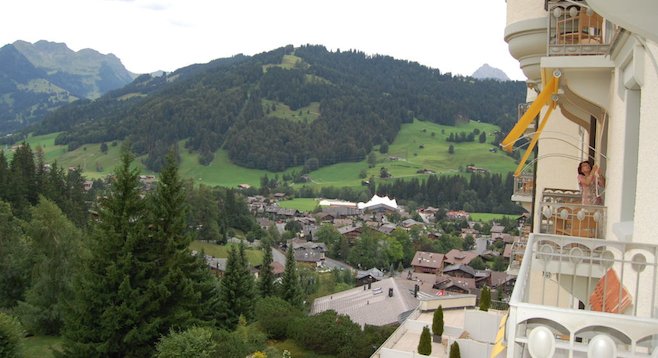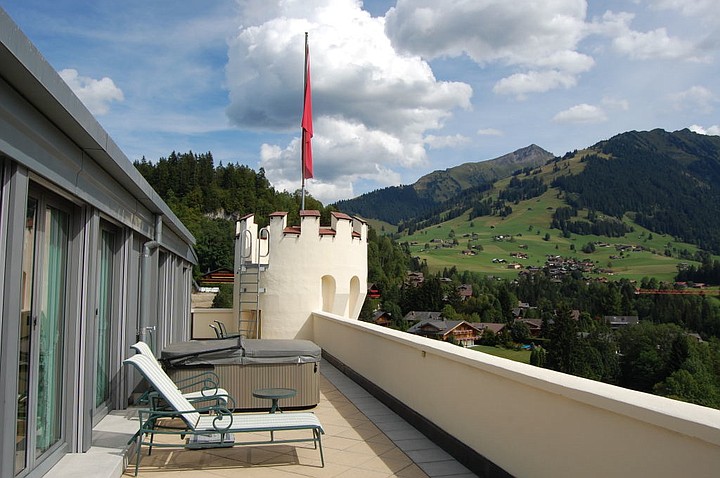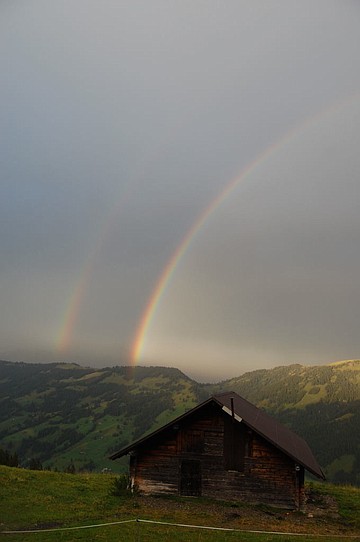 Facebook
Facebook
 X
X
 Instagram
Instagram
 TikTok
TikTok
 Youtube
Youtube

Built in 1913, Switzerland’s Gstaad Palace is an icon of Old World charm. By the ‘50s the posh hotel was attracting an international jet set, playing host to singers like Louis Armstrong and Ella Fitzgerald. It was popular with movie stars of the era, too. Elizabeth Taylor and Richard Burton visited, as did David Niven and Peter Sellers. Scenes of the Pink Panther films were shot on location.

Towering over a verdant valley in Bern Canton like a fairy-tale castle, the hotel overlooks the Saanenland region and a quaint village dating back to 1635 (left). Gstaad village hosts tennis, beach volleyball and polo tournaments as well as – interestingly enough – country-western festivals featuring performers like Kenny Rogers.
Like the Pink Panther’s Clouseau, guests enter the lavish lobby (complete with ornate gold chandelier) via revolving door. Down the hall is the well-stocked Lobby Bar with its display of matchbooks from venues around the world. An ibex’s mounted head adorns the fireplace across from the bar.
Assigned a reserved table by attentive tuxedo-clad waiters, I dined at Le Grill, devouring a grilled spring “farmer” chicken with citrus zest, olives, rosemary and veggies. Gildo’s Ristorante, named after the longtime maitre d’hôtel, is up a nearby flight of stairs, seasonally serving Italian cuisine. Palace restaurants require jackets at night.

The resort’s public spaces and private rooms embrace eye-popping vistas of the Bernese Oberland. The most expansive views are glimpsed from a palatial 800-square-foot penthouse, boasting private sauna, jacuzzi, elevator, kitchenette, three bedrooms and wrap-around balcony. Although less swanky, my spacious room had a walk-in closet, wooden-beamed ceiling and two balconies overlooking an Alpine emerald city.
For those who want to get away from it all, the hotel also owns the tin-roofed Walig Hut, built in 1786. Located 5,577 feet above nearby Gsteig, it’s designed for guests who want to rough it. The rural, ramshackle dwelling was originally used by farmers who brought their cows to pasture in Alpine meadows in the summer.

The Hut’s renovation was not a total makeover; it remains a primitive pine enclave minus most modern amenities. But one man’s shack is another’s chateau – and its scenery is delightful (left). (Although living like a peasant in the Palace’s hut costs a princely sum.)
I hiked the private path upwards as I’m stricken by “Alpinism,” which Mark Twain described in his A Tramp Abroad: “There is no opiate like Alpine pedestrianism… the spell… which people find in the Alps, and in no other mountains – that strange, deep, nameless influence, which, once felt, cannot be forgotten – once felt, leaves always behind it a restless longing to feel it again…”
At the Hut, where mutton skins cushion wooden benches, I dined on traditional fondue prepared on a wood-burning stove, served by Gildo’s headwaiter Maurizio Paglino. Plunging long forks into bread and potato chunks, I dipped them into the frothy caldera of molten cheese with a hint of alcohol (champagne truffle fondue is a Palace specialty) steaming and bubbling in a volcanic vat.

A dazzling double rainbow embraced the endless expanse of summits. Suddenly the Swiss serenity was shattered when the cows came home, literally, after a hard day of chewing grass uphill. One horned creature gave me the bull’s eye; wishing to avoid goring or stampeding, I retreated. The herd swarmed past Walig Hut, cowbells ringing out sonorously – heavenly heavy metal music.
With 150-plus miles of slopes, Gstaad is a mecca for skiers and other winter sports enthusiasts; mountain climbers, bikers and other outdoorsmen in summer. The hotel is well-stocked with recreational facilities, with tennis courts offering coaching by pros such as Grand Slam champ Roy Emerson. A 6,000-square-foot state-of-the-art wellness center features eight treatment rooms, a private spa suite and public spaces for lounging in style.
Romina, a body and beauty therapist from Turin, gingerly applied my first facial, purifying and exfoliating, restoring my skin to a youthful luster. Wearing oil-scented gloves as part of her aromatherapy, she kneaded my flesh in an hour-long massage. Vivaldi played throughout; the Four Seasons never sounded so good.
After the treatment, I almost felt young enough to boogie the night away at GreenGo, Gstaad Palace’s nightclub built when disco reigned supreme, where drinks start at 35 francs and music at 11:00 p.m.
Illuminated at night during the winter, Gstaad Palace resembles a birthday cake, snow doubling as frosting. A fitting symbol as this venerable five-star celebrates its centennial in 2013.


Built in 1913, Switzerland’s Gstaad Palace is an icon of Old World charm. By the ‘50s the posh hotel was attracting an international jet set, playing host to singers like Louis Armstrong and Ella Fitzgerald. It was popular with movie stars of the era, too. Elizabeth Taylor and Richard Burton visited, as did David Niven and Peter Sellers. Scenes of the Pink Panther films were shot on location.

Towering over a verdant valley in Bern Canton like a fairy-tale castle, the hotel overlooks the Saanenland region and a quaint village dating back to 1635 (left). Gstaad village hosts tennis, beach volleyball and polo tournaments as well as – interestingly enough – country-western festivals featuring performers like Kenny Rogers.
Like the Pink Panther’s Clouseau, guests enter the lavish lobby (complete with ornate gold chandelier) via revolving door. Down the hall is the well-stocked Lobby Bar with its display of matchbooks from venues around the world. An ibex’s mounted head adorns the fireplace across from the bar.
Assigned a reserved table by attentive tuxedo-clad waiters, I dined at Le Grill, devouring a grilled spring “farmer” chicken with citrus zest, olives, rosemary and veggies. Gildo’s Ristorante, named after the longtime maitre d’hôtel, is up a nearby flight of stairs, seasonally serving Italian cuisine. Palace restaurants require jackets at night.

The resort’s public spaces and private rooms embrace eye-popping vistas of the Bernese Oberland. The most expansive views are glimpsed from a palatial 800-square-foot penthouse, boasting private sauna, jacuzzi, elevator, kitchenette, three bedrooms and wrap-around balcony. Although less swanky, my spacious room had a walk-in closet, wooden-beamed ceiling and two balconies overlooking an Alpine emerald city.
For those who want to get away from it all, the hotel also owns the tin-roofed Walig Hut, built in 1786. Located 5,577 feet above nearby Gsteig, it’s designed for guests who want to rough it. The rural, ramshackle dwelling was originally used by farmers who brought their cows to pasture in Alpine meadows in the summer.

The Hut’s renovation was not a total makeover; it remains a primitive pine enclave minus most modern amenities. But one man’s shack is another’s chateau – and its scenery is delightful (left). (Although living like a peasant in the Palace’s hut costs a princely sum.)
I hiked the private path upwards as I’m stricken by “Alpinism,” which Mark Twain described in his A Tramp Abroad: “There is no opiate like Alpine pedestrianism… the spell… which people find in the Alps, and in no other mountains – that strange, deep, nameless influence, which, once felt, cannot be forgotten – once felt, leaves always behind it a restless longing to feel it again…”
At the Hut, where mutton skins cushion wooden benches, I dined on traditional fondue prepared on a wood-burning stove, served by Gildo’s headwaiter Maurizio Paglino. Plunging long forks into bread and potato chunks, I dipped them into the frothy caldera of molten cheese with a hint of alcohol (champagne truffle fondue is a Palace specialty) steaming and bubbling in a volcanic vat.

A dazzling double rainbow embraced the endless expanse of summits. Suddenly the Swiss serenity was shattered when the cows came home, literally, after a hard day of chewing grass uphill. One horned creature gave me the bull’s eye; wishing to avoid goring or stampeding, I retreated. The herd swarmed past Walig Hut, cowbells ringing out sonorously – heavenly heavy metal music.
With 150-plus miles of slopes, Gstaad is a mecca for skiers and other winter sports enthusiasts; mountain climbers, bikers and other outdoorsmen in summer. The hotel is well-stocked with recreational facilities, with tennis courts offering coaching by pros such as Grand Slam champ Roy Emerson. A 6,000-square-foot state-of-the-art wellness center features eight treatment rooms, a private spa suite and public spaces for lounging in style.
Romina, a body and beauty therapist from Turin, gingerly applied my first facial, purifying and exfoliating, restoring my skin to a youthful luster. Wearing oil-scented gloves as part of her aromatherapy, she kneaded my flesh in an hour-long massage. Vivaldi played throughout; the Four Seasons never sounded so good.
After the treatment, I almost felt young enough to boogie the night away at GreenGo, Gstaad Palace’s nightclub built when disco reigned supreme, where drinks start at 35 francs and music at 11:00 p.m.
Illuminated at night during the winter, Gstaad Palace resembles a birthday cake, snow doubling as frosting. A fitting symbol as this venerable five-star celebrates its centennial in 2013.
Comments